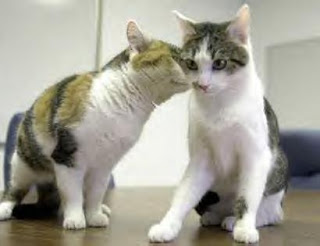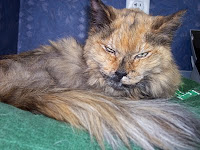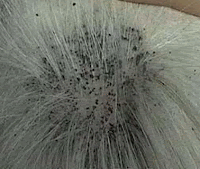Myths:
1) All orange cats are male.
2) All calico cats are female.
3) Rare calico males are worth a lot of money, and cannot reproduce.
 |
| Rainbow and CC - a cloned cat and her "mother" |
Reality: Feline coat color genetics can be very confusing. One of the great scientific experiments 10 years ago was that of cloning a cat. Rainbow was her name, and CC (Copy Cat) was her clone - they have the exact same DNA, but they look quite different. Rainbow is a calico and CC is a brown tabby and white cat. This just helps to illustrate how complex this situation is!
1) Orange cats can be male or female.
First, a little about genes: The gene for orange coat color is classified as a sex-linked gene because it is carried on a sex chromosome. The genes that make us male or female are on the X- and Y-chromosomes. An X from the mother and an X from the father makes XX or female. An X from the mother and a Y from the father makes XY or male. The male is the one who determines the sex of the offspring.
 |
| Orange tabby cat with a typical "M" marking and faint leg stripes |
The orange gene doesn’t add orange hair coloring to white fur, it actually changes black pigment into a reddish pigment. The orange gene is carried only on the X chromosome. Since a normal male has XY chromosomes, he only needs to inherit one orange gene for him to be an orange cat. A normal female is XX genetic makeup so she must inherit two orange genes to be an orange cat. If she inherits only one orange gene, only some of the black color will be converted to orange, so she will be a patchy orange and black coloration called a “tortoiseshell” or “tortie”.
Also, if you look closely, all orange cats have tabby markings. Sometimes the tabby markings may be limited to just the “M” above the eyes, or stripes on the legs or tail, but they are always there. They are also visible in the orange areas of tortie cats. This is because the gene that turns off tabby to give solid color cats does not work on the orange color.
Since females must have two orange genes to be a pure orange cat, they are less common than male orange cats, but they are not considered to be rare. If two orange cats breed, they will have orange offspring, because both the X-chromosomes in the mother and the X-chromosome in the father will all have the orange gene.
The genetics of orange or ginger coat color is explained in more detail in Tortoiseshell and Tri-Colour Cats (orange is caused by the same gene as tortoiseshell).
 |
| Ginger, our favorite tortoiseshell |
2) Tortoiseshell and calico cats can be male or female, too!
How can this be, since we just learned that of the male has the orange gene, all his black color will be changed to orange?
First, "tortoiseshell" refers to a mottled coat pattern of orange and black with very little white. This coat pattern can also be grey or blue-ish and cream, but is then called "dilute tortoiseshell".
 |
| Cleo, a lovely calico |
There are three ways that a male cat can end up with calico coloration:
1) Chimerism – Something happens during the pregnancy to cause two embryos to fuse together. If one has genes for black coat color and the other has genes for orange coat color, and one or more of the embryos are male, the result may be a tortoiseshell or calico male. This scenario is most common in animals that give birth to large litters…just like cats. These cats will be fertile, however, their offspring will not be calicos or tortoiseshells, since they can only pass on one X-chromosome at a time.
2) Klinefelter Syndrome – XXY chromosomes. Since it has a Y chromosome, this cat will be male, but since it has two X chromosomes, it is able to have one X-chromosome with the orange gene and one X-chromosome with the black gene. These cats will be sterile.
3) Somatic Mutation – During development, an orange male develops a black patch, which happens similarly in human babies with port wine stain birthmarks. These cats will be fertile.
3) While calico and tortoiseshell males are rare, and scientifically interesting, they are not really more valuable than other cats, even if they are fertile males.
The offspring of these cats will not have any more likelihood of being calico males or male tortoiseshells than any other cat, so their total "worth" is usually as much as their breed is worth. For example, a Grand Champion purebred calico male Persian will be worth more money than a stray calico male off the street. The genetics of tortoiseshell males is explained in more detail in Tortie Tomcats.
There is, however, a superstition is that these cats are good luck.
Of course, we all know that the true worth of a cat is in its personality and affection, and the joy that it brings to our homes - male or female, calico or not!










